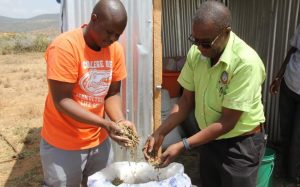Pastoralists in Laikipia County are now set to turn the cactus menace into a fortune, following a successful project of converting the invasive plant into processed animal feeds.
The research conducted by the Jomo Kenyatta University College of Science and Agriculture (JKUAT) and US-based Florida University involves how the succulent plant can be converted into pellets to feed livestock.
JKUAT Food Scientist Professor, Willis Owino, reveals that the success of the project, of which the two institutions have been testing in the past six months at Makurian village in Laikipia North Sub-county, will go a long way in cushioning livestock farmers from the adverse effects of recurrent droughts.

“Animal feed in this area is a major challenge, especially during the dry season in which the community loses a substantial number of livestock, including cows, goats, sheep, and camels. We felt that it was important to utilise this cactus to produce pellets and address the loss of livestock,” says Professor Owino.
The process of producing the pellets involves chopping the flat stem, including leaves into small pieces, which are sun-dried and grinded into a flour-like substance, which is then fed into a pellet-making machine.
When the media visited the research site, some goats were put under experimentation in a feedlot-like system, and others were left to traditionally graze in the rangelands.
According to Owino, the research has established that pellets from the drought-resistant plant can greatly assist in fattening livestock, where goats that were put under experiment gained nine kilogrammes within 85 days, compared to their counterparts.
“We are trying to establish if feeding these cactus pellets would be able to sustain the goats and positively increase their weight. We have observed that the goats that were feeding on the cactus pellet gained weight upwards to nine kilogrammes,” reveals the Food Scientist.
He notes that with the overwhelming results, they have embarked on registrations with various agencies to enable them to produce the pellets commercially.
“This pellets become quite useful as livestock feed, and it’s important to produce them on a large scale; however, this involves several steps, including registration, approvals, and protection of intellectual property,” points out Owino.
Kenneth Oduor, a PhD student at Florida University, notes that for over a decade now, efforts to eradicate the cactus species-opuntia stricta, which has colonised hundreds of acres within Maiyanat and Murpusi community lands, have borne little fruit. With their breakthrough research, there is a need to utilise the plant in supporting farmers to get animal feed and control soil.
“We are evaluating other benefits that this invasive species can provide to the community since previously it had been labelled as a bad species that needed to be eradicated; however, there is a need to relook into this since things like soil erosion and nectar production, which makes the honey, are dependent on cactus,” Oduor urged.

Additionally, he says that they target the policymakers to change laws existing on the eradication of the invasive cactus plant, which has turned out to be a fortune for the local communities in the animal feed production sector.
“All cacti in Kenya are considered invasive, and the main goal is to eradicate them, but there is a need to re-look since countries such as Brazil, Mexico, Tunisia, and South Africa are having large plantations of cacti in their rangeland to feed livestock,” reveals Odour.
He says that 80 per cent of Kenya is dry land, and using the already existing plant such as cacti that can withstand hot temperatures, would transform the livelihoods of the livestock keepers.
Oduor reveals that in case the invasive cactus is complete, the introduction of spineless cactus would be ideal for the farmers in the future.
The cactus that was introduced to Kenya by colonial administration has been blamed for causing deaths to livestock that feed on its brightly purple-coloured fruit with tiny spines, resulting in injuries to the animals’ digestive systems.
Control methods that have been applied in the past include chopping the drought-resistant plant with machetes, manual uprooting and burying, herbicide application, burning, and biological control with predator insects—cochineal that was brought in from South Africa in 2016.
However, the noxious weed continues to spread fast, with the consumption of cactus fruit by livestock and wild animals facilitating seed dispersal.
Local communities are optimistic that turning the cactus into fodder presents the ultimate solution to the problem they have lived with for years and which has been taking a toll on their main source of livelihood—livestock rearing.
They are now appealing to the national and county governments to fast-track policy implementation so that community groups can invest in the commercial production of the cactus pellets.
By Muturi Mwangi


